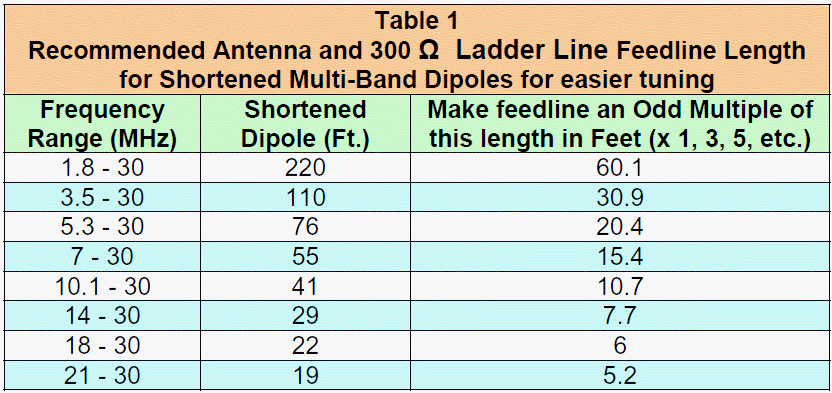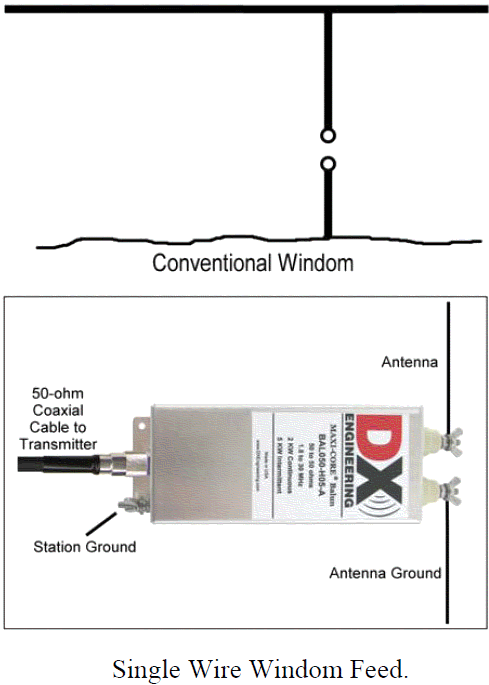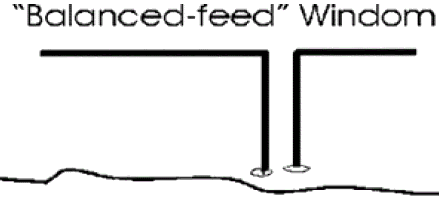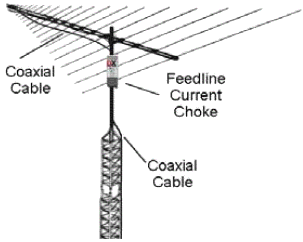|
Balun is an acronym for BALanced to UNbalanced, which describes certain circuit behavior in a transmission line, source or load. Most communications applications deal with two-terminal sources, transmission lines, and loads. This includes coaxial cables, open wire lines and systems working against earth or a ground plane as the "second conductor".The balun has to do a good job and be reliable. DX Engineering has the expertise to design and build a better balun that will deliver more power to the antenna, be more reliable, and in many cases cost less than products made by others. We also realized that advertising hype over the years had confused the issue of just what type of balun was appropriate to each antenna. This article is an attempt to define in simple terms how to get the most performance from your system, both on receiving and transmitting. The balun's ratio is normally stated from balanced to unbalanced, just as the words appear in the acronym. A 4:1 balun has four times the balanced impedance as unbalanced impedance. Balanced lines and loads, by definition, have equal voltages from each terminal to ground. Each balanced terminal or conductor must also carry precisely equal and exactly out-of-phase currents. If the feedline does not have equal voltages, equal currents, and exactly out-of-phase currents at every point, the feedline will partially act like an antenna. Current is most important to balance. Voltage is less important, although voltage can be important in specific cases. Coaxial feedlines, like balanced lines, must also have exactly equal and opposite currents on the shield and center conductors. Equal and opposite currents can only flow inside the shield. Coaxial line shields also must have zero volts radio-frequency electrical potential to "ground" or space around the line at the operating frequency. Deviations from this ideal case will cause current flow on the outer surface of the shield. This current will cause line radiation, since it flows outside the shielding wall. There are two types of baluns: Current Baluns and Voltage Baluns.In both balanced and unbalanced lines, we call vector current difference between the two conductors "common-mode current". Common-mode current causes nearly all feedline radiation and RF-in-the-shack problems. Reducing or eliminating common-mode current as close to the antenna as possible, and keeping it from reappearing inside the shack, can greatly improve reception and put more transmitter power in the antenna. It will also reduce RFI problems. What many of us fail to understand is most real-world antenna systems are neither perfectly balanced nor perfectly unbalanced. Real-world antenna systems most often are somewhere between perfectly unbalanced and perfectly balanced. In most cases, baluns are installed as close as possible to a balanced-to-unbalanced transition point. Current Baluns Current baluns allow each output terminal's voltage, with respect to "ground" or chassis, to float to any value required to provide equal currents to each feedline conductor. Current baluns are universal devices that work with balanced or unbalanced loads equally well. Current baluns add common-mode isolation between systems connected at each end. While traditionally used as baluns, they work well as broadband phase-invertors or as an un-un. Current baluns isolate or add impedance to unwanted common-mode current paths, reducing or controlling common-mode current. Current baluns are the balun of choice in all but very specialized situations, because they work better than voltage baluns in most real-world systems. In the case of a 1:1 ratio current balun, core flux density or "magnetizing stress" on the balun core is independent of load impedance or load mismatch. Only common-mode current affects the core. This does not mean current baluns can handle infinite power or mismatch, but it does mean for equal materials and cost they handle extremes in impedance much better than baluns that operate at higher ratios. Reasons for always using a current balun:
Voltage Baluns Voltage baluns always try to force the output terminals to equal voltages. They sometimes introduce phase shift between each output terminal and "ground". If the impedance presented at each terminal is not exactly equal, feedline or load currents will not be equal and opposite. This means the feedline will radiate. They also do not provide common-mode isolation. A voltage balun almost certainly guarantees some feedline radiation (or reception), because there are very few "perfectly balanced" loads or perfect voltage baluns. Unlike a 1:1 ratio current balun, a voltage balun will always magnetize its core in direct proportion to load voltages. In a voltage balun, load impedance directly affects core heating and flux density. Systems Requiring Antenna Tuners Antenna systems requiring antenna tuners or matching networks often have very high voltages or currents on transmission lines and baluns, even at modest power. In many cases, voltage and current are not in phase with each other. This can produce very high currents at the same place where voltages are very high, the worse of both conditions appearing at one point in the system. In some installations, coaxial cable connects a poorly matched balanced antenna directly to a tuner. The tuner "matches" the poor antenna system impedance to station equipment. The feedline beyond the tuner still has very high voltage, current, and loss, even if tuner input has a perfect SWR. With coaxial feed, any balun would belong at the antenna, not at the tuner. In other installations, both the antenna and antenna feedline are balanced and the tuner has an internal or external balun. Unfortunately, most internal tuner baluns are 4:1 voltage baluns, which we will see is a poor choice. In this case, the baluns should be as close as possible to the tuner. Less often, balanced tuners are used. Such tuners come in two styles. One is a true balanced voltage network like the old E.F. Johnson Matchbox. Other better forms include link-coupled homemade tuners with fully floating tuned circuits, which behave as a more desirable floating current source. A more recent approach is a balanced network with a balun on the input. While a balanced network with grounded center is balanced, it is a voltage-type source like the Matchbox. It needs a perfectly balanced load to function optimally. Balance is not as good as a link-coupled tuner with fully floating components. Unbalanced networks with baluns on the input are not what we first might think. The balun has just as much core stress and flux density when placed at the input as it would have when in the traditional location, on the output. Common-mode isolation is also the same as a traditional current balun on the tuner output. Relocating the balun to the input of an unbalanced network does not help the balun do a better job and complicates tuner construction. The ideal balanced tuner would have a link-coupled floating balanced network. Nothing else will assure optimal transmission-line balance. The output network must be ground independent. Otherwise, it is a resonant equivalent of a voltage balun. We are often further ahead to place a good 1:1 ratio current balun at the output of a traditional "T" network tuner. In fact, even though I can build any type of tuner I want, all of my personal high power tuners are simple "T" networks with good 1:1 ratio current baluns on the output. Four areas of concern in tuner-matched systems
Half-wave Dipoles A resonant half-wave dipole is typically fed with coaxial feedline and tuned to a specific area of a band. Its planned use is generally within that band, although it may be useful on other bands (near odd-harmonics) where feedpoint impedance reasonably matches the coaxial feedline. The well-known length formula is L (feet) = 468/Frequency (MHz). This formula is an approximation. Antenna height, leg angles, insulation, wire diameter, and surroundings affect a dipole's resonant frequency and impedance. It is better to initially make the antenna a few percent longer than calculated and trim it back to size (higher in frequency), although dangling pigtails will work to slightly lengthen an antenna (reduce frequency) without adverse electrical or mechanical affects. A popular misconception is because the dipole is resonant, or because the dipole feedline is small in diameter, a balun is not helpful. There are also questionable claims that "feedline radiation is good", or pattern change without a balun is insignificant. Many of these claims contradict each other. If one is true, the other claim argues against it. That is, what happens when we justify a questionable practice. Indeed there are cases where a balun is not needed at the balanced to unbalanced transition between coax and dipole, but they are very specific cases where the feedline is suspended in air from the center of the antenna straight away from the feedpoint, and is grounded ¼ wavelength away from the feedpoint. Omitting the balun in other cases will often cause feedline length to affect SWR, increased noise in the receiver, increased RFI, or any combination of these ill effects. In unlucky cases with higher Amateur power levels permitted, omission of a balun can cause coaxial shield or connector arcing to tower legs or other metallic objects. Best balun for this application is a 1:1 ratio current balun. This antenna can use a coaxial cable feed and the balun is located right at the dipole element to ensure that the each side of the element receives equal currents and prevents external shield currents. The feedline should route straight away from the antenna center at right angles to the antenna conductor. This will keep the antenna's fields from introducing current on the outside of the feedline after it leaves the balun, and will keep the feedline from introducing noise onto the antenna element. Ladder Line or Open Wire fed Dipoles or Doublets A Multi-band Dipole or Doublet antenna system is a single length wire antenna useable on virtually any band where a tuner can provide a match. Efficiency is very good when the antenna is 0.4 wavelengths long or longer. Efficiency drops rapidly with antennas shorter than 0.4 wavelengths. This is a popular antenna system. A simple multi-band dipole may be constructed by first choosing the lowest band on which operation is desired. The overall length of the multi-band dipole antenna should be shorter than one-half wavelength. For best efficiency, ladder line feed and a good antenna tuner with balanced connections are required. The ideal balun is a 1:1 ratio balun. It can be connected through a short length of coaxial cable to an unbalanced tuner for tuning the different bands. Although it may not seem logical, for 160 through 10-meter operation, a dipole around 220 feet long may actually help antenna tuner and balun performance, especially on lower frequencies. This is because standing waves on the transmission line transform or change reactance and resistance presented to the balun and antenna tuner.
The coaxial cable from 1:1 balun to the tuner should be kept short - 10 feet or less is best. The recommended 300-Ω ladder line provides better overall impedances at the tuner and balun, as opposed to typical 450-Ω ladder line. Conductor resistance dominates transmission line losses below VHF, so choose the largest diameter conductor you can for a given transmission line size and impedance. Do not substitute smaller conductor television-style feedline to save money. Losses will increase. The 300-Ω ladder feedline for a multi-band dipole must be in odd multiple lengths of 1/8 wavelength on the lowest operating frequency. This helps optimize impedance presented to the balun and tuner over the frequency range of the antenna. Coupler If you have excess ladder line, it can be zigzagged while suspended in air, but it can't be closer than a few conductor widths to metallic objects and cannot be coiled on itself or laid on the ground. If it is necessary to pass closely to a metallic object, twist the line to partially balance the effect on both sides of the feedline. Ideally, the feedline should be brought away from the antenna at right angles. 250-350 ohm impedance feedlines result in less extreme impedance changes from band-to-band. They are a good compromise between impedance extremes and feedline losses. For instance, 600-Ω feedlines tend to present wider load impedance variations at the tuner in multi-band applications than lower impedance feedlines. In addition to better impedance performance, the 300-Ω line has less wind drag than 450-Ω window line. Coaxial cable has too low of an impedance, higher initial matched loss, and significantly higher SWR on bands where the antenna feedpoint impedance is high. True open wire feedlines are much more difficult to build and maintain. Their 500-Ω to 800-Ω impedance allows low-loss multi-band operation, but band-to-band impedance variations at the balun and tuner are greater. 300-Ω transmitting feedline is a better choice, since it moderates multiband impedance extremes and still offers significantly less loss than coaxial cable in this application. Do not use coaxial cable when SWR is high. For each 100 feet of coaxial cable, you lose half your power at an SWR of 10:1. At frequencies higher than 14 MHz, it's worse. For higher loss coaxial cables, like RG-58 or RG-8X, have even more loss. Plus, the SWR shown here is measured at the antenna, not at the radio. At the radio, SWR would measure significantly lower because the lossy feedline absorbs reflected power. Feedline length with multi-band dipoles. Feedline length is critical to antenna tuning and performance. Always choose a feedline (connects the antenna to the balun, in this instance) that is 1/8th wavelength or some odd-multiple of 1/8th wavelength long on the lowest band. The best balun for this application is a 1:1 ratio current balun. A 1:1 balun has the widest operating frequency range, lowest core stress, and provides the best overall balance of any balun for given cost, size, and weight. Do not match the balun impedance to the transmission line impedance. The transmission line is grossly mismatched. This means the impedance at the balun and tuner varies greatly from band-to-band. Tuners have an easier time with modest to high impedances. They don't work well into very low impedances. A balun with a ratio of 4:1 or more will transform the already low impedances appearing on some bands to even lower values. This will greatly reduce system efficiency and reduce tuner power ratings. The 1:1 ratio balun will just pass the low impedance through. In addition, higher ratio baluns will not handle differential impedance extremes nearly as well as 1:1 current baluns. For ladder-line fed antennas, the balun should be located near the tuner, keeping the coaxial cable between it and the tuner as short as possible. Avoid routing the line parallel and close to other conductors or structures for any significant distance. Keep feedline length inside a dwelling as short as possible to reduce chances of RF feedback. Coupling directly from the line to sensitive wiring can cause distorted transmitted audio, often described as "RF in the audio" or CW keyer malfunctions. In severe cases, there may be enough RF present on the microphone, key, or other equipment to cause an RF burn. Even when properly done, this arrangement will subject the coaxial line between the tuner and balun to very high standing waves and high voltage and/or current. You should use good low-loss coaxial line and keep the coaxial line as short as possible. RG8/X and smaller will not do a proper job. Belden RG-213 or equivalent is the minimum size that handles the higher voltages and currents properly. Conventional or True Windom Antennas The true or conventional Windom antenna is fed with a single-wire line, and fed as an unbalanced system against a reasonable RF ground or counterpoise. The feed is similar to a longwire antenna, except the horizontal wire is fed with a few percent offset from the center.
When you use a single wire feed, ground the unused balanced terminal to the counterpoise or radial system. DO NOT connect that system to the station ground. Isolating the station ground from the antenna ground will keep unwanted RF off station equipment, and reduce potential problems with unwanted RF in the house. Balanced Feed Windom Antennas Off-Center Fed Dipoles Another, more popular version of a Windom antenna is fed with open wire or ladder line. It is sometimes called a "balanced feed" Windom, even though it is actually an "Off-Center Fed" dipole.
Properly installed Windom balanced feed or off-center fed antennas have impedances in the 200-400 Ω range at resonant frequencies. Depending on the installation, a Windom antenna may have reasonable impedances at several harmonically related frequencies. The best balun for both antennas, assuming they operated where standing waves on the feed system are low, are 4:1 baluns. Current baluns, as mentioned earlier, can be used to feed unbalanced loads or balanced loads. When using a balanced feed system, the length of the feedline is an odd-eighth-wave depending on the lowest frequency used. The best balun for the Windom or Off-Center Fed Dipole is a 4:1 ratio current balun. End or Non-symmetrically Fed Antennas Antennas that are end-fed or asymmetrically fed almost always cause unwanted current on feedline shields. Examples would be a "dipole" or vertical, either symmetrically or asymmetrically constructed, where the feed cable leaves the antenna near a high voltage point. This can be because of a marginal counterpoise, because the coaxial cable itself is the counterpoise, or because the feedline routes along or through the antenna.
Commercial examples of this are Gap, MFJ, HyGain, and Cushcraft "no radial" verticals, as well as Force 12 vertical dipoles. In these cases, a feedline current choke placed no more than five feet away from the antenna feedpoint will greatly reduce feedline currents. 50 Ω Broad Band Antennas One manufacturer of log-periodic antennas suggests running the feedline along a boom that is "hot" with RF, which means the shield of the coaxial cable is coupled directly to one conductor of a "hot" transmission line! In this case, a feedline current choke should be placed at the point where the feedline leaves the antenna boom, but before it reaches the tower.
Feedline Current Choke Use with any vertical or horizontal antenna that is coaxially fed. The RF isolated SO-239 provides a high common-mode impedance from 1.8 to 60 MHz. Examples where this may be necessary are:
In all of these cases, a feedline current choke will greatly reduce unwanted or harmful feedline radiation or reception. The feedline current choke should be installed several feet away from the radiating antenna. In all cases, it must be installed before the feedline is routed against other cables, a metallic mast, or a tower. Benefits of using a Feedline Current Choke The above antenna examples usually have very high common-mode feedline currents which often lead to:
While most common advice is to improve the station's RF ground, the root of the problem is in the poor isolation of the feedline from antenna currents. If you wish to reduce feedline radiation and improve reception, a feedline current choke is a good idea. In these examples adding a feedline current choke at the point where the feedline exits the area of the antenna will substantially reduce unwanted feedline radiation or reception. This is something a station ground cannot do, no matter how good it is. Feedline current choke is not recommended for use on high SWR systems. Quarter-Wave Vertical Antennas Any antenna directly fed with a coaxial line against a ground system, like a quarter-wave vertical, depends on the ground system being at zero volts with respect to earth. Unless the ground connection point is held solidly at zero volts, current will be introduced onto the feedline shield. When the vertical uses elevated radials, it is difficult to keep current from traveling back to the operating position via the feedline unless a feedline current choke is used. Not only does this unwanted current cause RFI problems, it also reduces antenna system efficiency. With a ground-mounted vertical using a smaller ground system, and especially with poor radial systems, there is the need for a feedline choke or current balun system to keep unwanted currents off the outside of the feedline shield. The correct location for a choke system is at the base of the vertical portion of the antenna. Long-Wire Antennas Long wire antennas are typically horizontal antennas, fed at one end, and well over 1/2-wavelength long at the lowest operating frequency. The impedance of a long wire antenna varies as the frequency is changed, but the normally accepted values are from a few hundred to a few thousand ohms depending on length, height, ground conditions and frequency. The only way to know the impedance is to measure it or at least model it with antenna software. A 4:1 balun using good coaxial cable leading to an antenna tuner will provide a relatively well-behaved installation. One output terminal connects to the antenna. The other terminal connects to the antenna's ground or counterpoise. The ground ideally would be a modest system of radials. At the very least, an elevated counterpoise several feet above ground and parallel to the antenna is used. The counterpoise length should be ¼-wave on the lowest frequency planned. Multiple counterpoise wires will improve performance. The case of the balun should be attached to a separate ground rod. Rhombic, V-Beam, and Other Broadband Antennas Some antennas have very little impedance change with frequency. Log Periodic, Terminated Inverted V's, Terminated V-beam antennas, and Terminated Rhombic antennas are examples of antennas that have stable feedpoint impedances over very wide frequency ranges. Select a balun closest to the antenna feedpoint impedance (you'll have to get this from textbooks or modeling), and use it at the feedpoint or where the feedline from the antenna ends. Be sure the feedline between the balun and antenna feedpoint matches the antenna impedance as closely as possible. The balun for a terminated Rhombic, V-Beams and Other high impedance broadband antennas is the 12:1 model.
|




